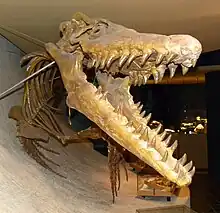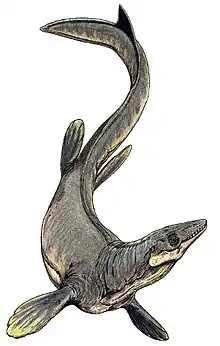Mosasaurini
Mosasaurini is a extinct tribe of mosasaurine mosasaurs who lived during the Late Cretaceous and whose fossils have been found in North America, South America, Europe, Africa and Oceania, with questionable occurrences in Asia. They are highly derived mosasaurs, containing genera like Plotosaurus, having unique adaptations to fast swimming speeds, or Mosasaurus, which is among the largest known marine reptiles.
| Mosasaurins Temporal range: Campanian-Maastrichtian, | |
|---|---|
 | |
| Skeleton of Mosasaurus (front view) in the Maastricht Natural History Museum. | |
| Scientific classification | |
| Domain: | Eukaryota |
| Kingdom: | Animalia |
| Phylum: | Chordata |
| Class: | Reptilia |
| Order: | Squamata |
| Superfamily: | †Mosasauroidea |
| Family: | †Mosasauridae |
| Subfamily: | †Mosasaurinae |
| Tribe: | †Mosasaurini Russell, 1967 |
| Genera | |
| Synonyms | |
| |
Description

The Mosasaurini form a clade of derived mosasaurine. The tribe contains one of the largest known mosasaur species, Mosasaurus hoffmannii, measuring over 12 m (39 ft) in length, but such a size is unusual within the tribe and even within the genus Mosasaurus in himself. Other large representatives are around 8 m (26 ft) long (like Plotosaurus, Eremiasaurus, Mosasaurus conodon and Mosasaurus beaugei) while others are even smaller, in a range of around 5–6 m (16–20 ft) long (like Mosasaurus missouriensis).[1]
Classification
The tribe was erected by Russell in 1967, stating that it is unified by having twelve or less pygal vertebrae and that the radius and ulna are widely separated by a bridge of carpalia on the distal border of the antebrachial foramen.[2] But In a 1997 study, paleontologist Gorden Bell recovered Plotosaurus, which was formerly classified within another tribe called the Plotosaurini, as a sister genus to Mosasaurus. This rendered the Mosasaurini paraphyletic, which meant that it now contains a descendant lineage (Plotosaurini) that is not classified under it, and made its definition defunct.[3] Paraphylys are forbidden in cladistics and so scientists must reclassify groups in order to eliminate such discrepancies if possible.[4] Bell proposed that the Mosasaurini should be abandoned and that all members of the tribe should be incorporated into the Plotosaurini. While other scientists agree that a tribe containing Mosasaurus should be monophyletic, they argue that Mosasaurini should be the valid tribe. For example, in a 2012 study, Aaron LeBlanc, Caldwell, and Bardet argued that, while it is not necessarily invalid, abandoning Mosasaurini would not follow the general principle of the type genus carrying over to all ranks in a classification hierarchy, and that the original diagnostics of the Plotosaurini is outdated.[5]
The taxa Mosasaurini has historically been more inclusive, on occasion including genera such as Plesiotylosaurus,[6] Liodon and Clidastes,[2] all of which are now seen as more basal mosasaurines.[7]
A more recently suggested definition is a branch-based definition diagnosing the Mosasaurini as the most inclusive clade containing Mosasaurus hoffmannii but not Globidens dakotensis.[8]
References
- Gregory S. Paul (2022). The Princeton Field Guide to Mesozoic Sea Reptiles. Princeton University Press. p. 208. doi:10.2307/j.ctv2hnkc6h. ISBN 978-0-69-119380-9. S2CID 251553177.
- Dale A. Russell (1967). Systematics and morphology of American mosasaurs. Vol. 23. New Haven: Bulletin of the Peabody Museum of Natural History. p. 240. OCLC 205385.
- Gorden L. Bell Jr. (1997). "A Phylogenetic Revision of North American and Adriatic Mosasauroidea". Ancient Marine Reptiles. Academic Press. pp. 293–332. doi:10.1016/b978-012155210-7/50017-x. ISBN 978-0-12-155210-7.
- "A brief primer for cladistics". Centennial Museum and Department of Biological Sciences, The University of Texas at El Paso. 2008.
- Aaron R. H. LeBlanc; Michael W. Caldwell; Nathalie Bardet (2012). "A new mosasaurine from the Maastrichtian (Upper Cretaceous) phosphates of Morocco and its implications for mosasaurine systematics". Journal of Vertebrate Paleontology. 32 (1): 82–104. doi:10.1080/02724634.2012.624145. S2CID 130559113.
- Dimitry V. Grigoriev (2013). "Redescription of Prognathodon lutugini (Squamata, Mosasauridae)" (PDF). Proceedings of the Zoological Institute RAS. 317 (3): 246–261. doi:10.31610/trudyzin/2013.317.3.246. S2CID 189800203.
- Tiago R. Simões; Oksana Vernygora; Ilaria Paparella; Paulina Jimenez-Huidobro; Michael W. Caldwell (2017). "Mosasauroid phylogeny under multiple phylogenetic methods provides new insights on the evolution of aquatic adaptations in the group". PLOS ONE. 12 (5): e0176773. Bibcode:2017PLoSO..1276773S. doi:10.1371/journal.pone.0176773. ISSN 1932-6203. PMC 5415187. PMID 28467456.
- Daniel Madzia; Andrea Cau (2017). "Inferring 'weak spots' in phylogenetic trees: application to mosasauroid nomenclature". PeerJ. 5: e3782. doi:10.7717/peerj.3782. PMC 5602675. PMID 28929018.
